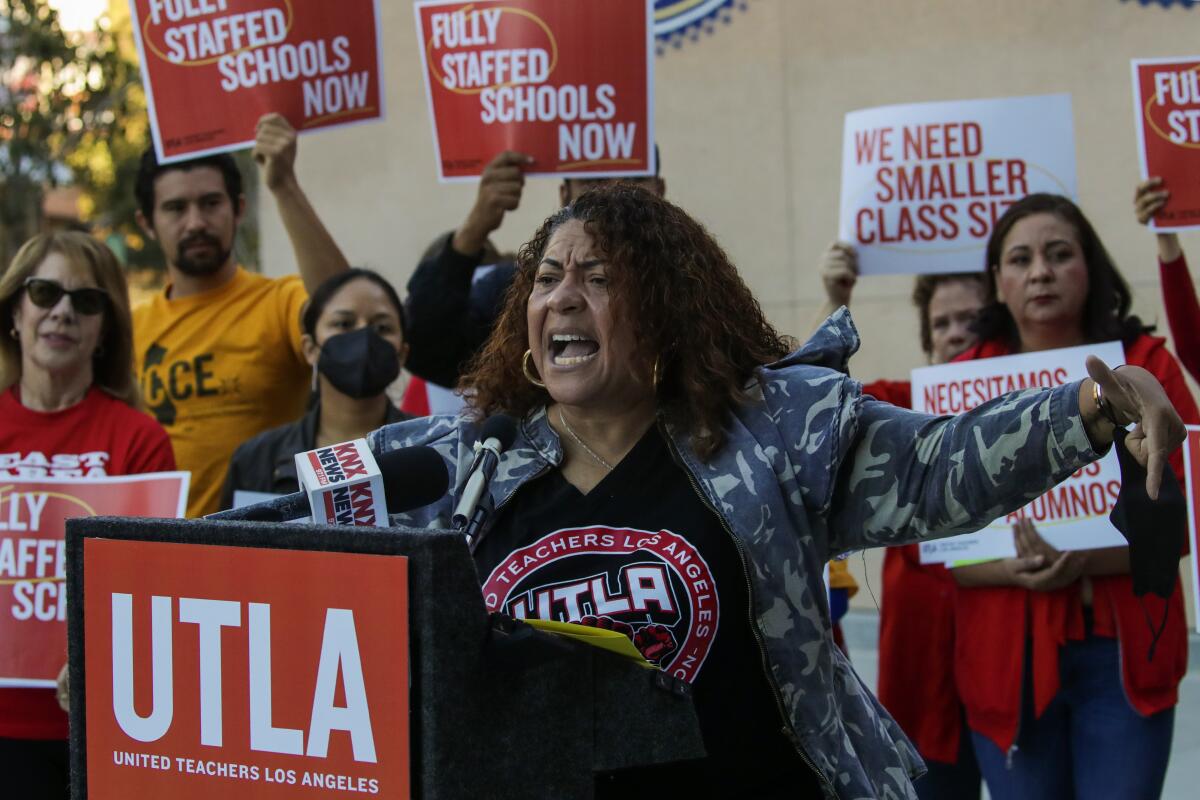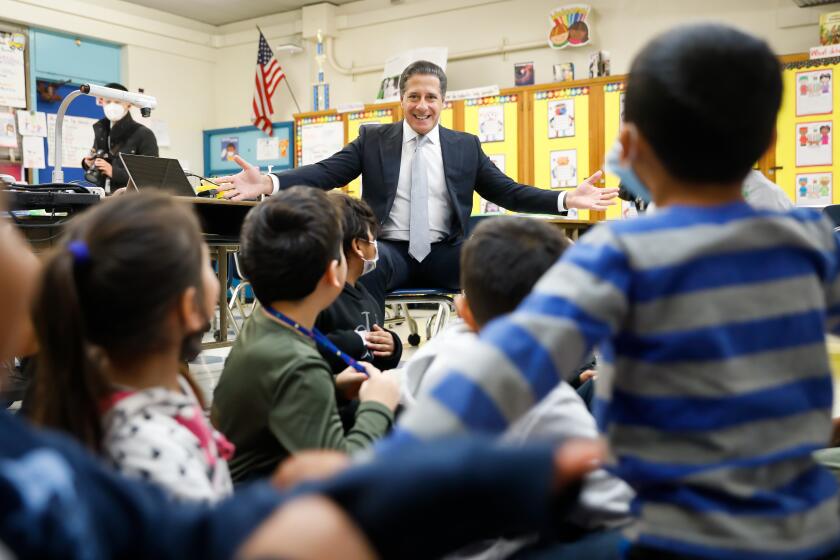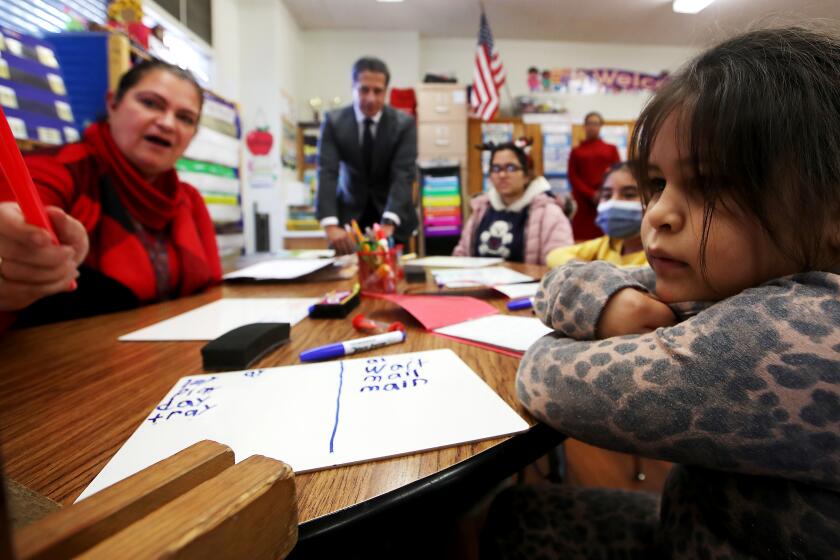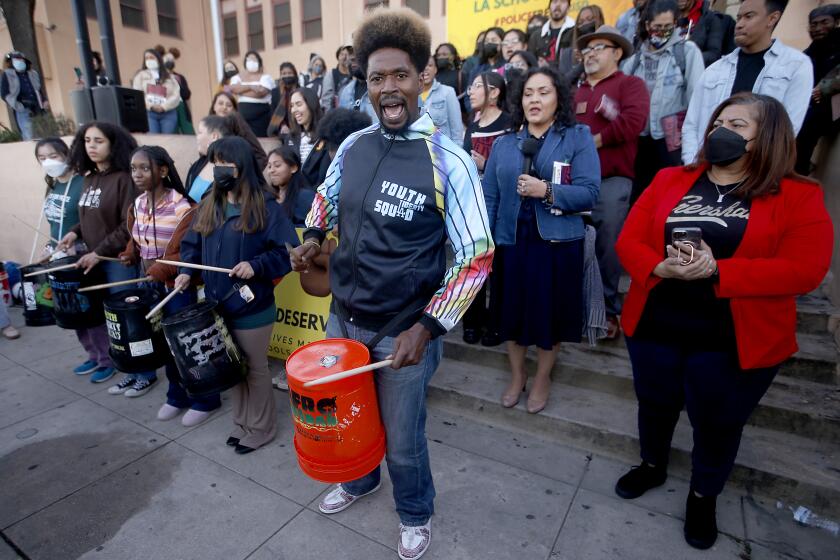What an off-the-radar teachers union election means for the education of L.A. children

When L.A. schools Supt. Alberto Carvalho wanted to extend the academic year, the teachers union stopped him. When his predecessor, Austin Beutner, wanted more live Zoom teaching during the pandemic, the union also stopped him. And when the district was preparing to reopen campuses for in-person learning, the union demanded that teachers first have the opportunity to be fully immunized against COVID-19.
When it comes to local schools, United Teachers Los Angeles wields significant influence. This week its members are deciding who will wield power within the union in an election sure to affect public education at a critical moment for students’ academic recovery from the pandemic.
The 35,000-member union of teachers, counselors, librarians and nurses is likely to have a say in any renewed efforts to extend the school year or school day, which affects working hours. Union leaders also will bargain over how and where to lower class sizes and weigh in on whether to shorten winter break from three weeks to two weeks. There’s also been a decades-long push and pull over who controls what happens at schools as far as teacher assignments, hiring and spending.
The coming months feel critical for teachers, who, like their students, have struggled to get back to normal as the pandemic has eased. The stress of catching up children who are behind academically and acting out emotionally has prompted many to retire, leave the profession or consider doing so. High inflation and housing prices make it difficult to live in Los Angeles on a teacher’s salary.
The union’s sweeping list of bargaining priorities takes on such areas as funding for the Black Student Achievement Program, specifics on organizing the district, building affordable housing for low-income families, environmental justice, healthy food, trauma-informed teaching, techniques for de-escalation of conflict and increased access to ethnic studies.
The union bloc in place for nearly a decade is vying to extend its run — and has emerged as the heavy favorite in online, members balloting.
President Cecily Myart-Cruz, 49, seeks a second term with a recently assembled all-woman slate after taking over from coalition leader Alex Caputo-Pearl, who served as president for the maximum of two terms. Myart-Cruz has positioned the union as a progressive voice for underserved Black and Latino students; she’s also pushing for a 20% raise over two years in ongoing negotiations.
In January 2019 teachers went on strike for six days and won some key concessions — such as a cap on class sizes — although the strike itself did not result in higher pay or better benefits. To avoid another strike, the union and school district must agree on wages that are generous enough to recruit and retain teachers as the district faces economic uncertainties.
Los Angeles Unified Supt. Alberto M. Carvalho has a high-voltage style and ambitious agenda, although it’s too soon to gauge his success as students struggle with pandemic setbacks.
The union’s internal challenges include recruiting dues-paying members — now that the Supreme Court has barred mandatory membership in public employee unions. Close to 12.5% of eligible workers have opted out of joining the union, according to L.A. Unified records obtained by California Policy Center, which has the self-described mission of reigning in “government union power.”
It’s difficult to gauge where the union stands with parents. Union leaders point out that member working conditions are student learning conditions — they share a common interest. Union critics, however, challenge whether the leadership is serving members well, let alone district families.
A statewide poll last year indicated no major political shift in attitudes toward teachers unions. Voters remain widely divided, especially along partisan lines, with Republicans and conservatives far more critical. Overall confidence in schools, however, had declined in the wake of the pandemic.
“The real question for the union, regardless of who’s running it is: Is what’s good for the union, in terms of what they’re advocating, also good for the students?” said Pedro Noguera, dean of the USC Rossier School of Education. “That’s what parents want to know. To the degree that parents don’t perceive that to be the case, then the union can find itself losing support.”
Myart-Cruz did not make herself available for an interview, but provided a statement expressing pride in the union’s work and her commitment “to fight for our school communities.” She laid out her vision in the union’s one members-only campaign forum. Each candidate was permitted to respond briefly to the same three questions.
When asked to cite three big issues, Myart-Cruz listed: “educator burnout, attacks on public education, and attracting and retaining educators because of pay disparity, [lack of ] livable wages and housing.”
She also talked about her leadership approach.
“My vision for UTLA is to build on the collective work we’ve done over the course of the many years,” she said. “We have to listen to our members. ... We have to include students and parents and community voices. We must be antiracist in our practices. And we have to continue our work with coalitions locally, statewide and at the national level.”
Attendance was about half as much as L.A. Unified initially announced, a deeper review of data shows. The two extra learning days during winter break cost $36 million.
She talked too of building power at campuses, reducing standardized testing and fighting for racial and social justice. She also underscored fighting “privatization,” which to union members means opposing privately operated public charter schools, blocking the use of tax dollars for private-school tuition and facing off against initiatives and candidates backed by hostile donors and foundations.
Her message, said Joel Jordan, a retired district teacher and former UTLA director of special projects, “demonstrates the overwhelming victory of militant, progressive unionism in UTLA. The days of pure and simple bread-and-butter unionism in UTLA are over. It is the new norm that UTLA will attempt to bargain, not just over salaries and benefits, but over class size, expanded support services, as well as other nontraditional contract priorities.”
The union’s broad priorities are necessary because children and families have so many needs, said Theresa Montaño, a district grandparent and professor of Chicana/Chicano students at Cal State Northridge.
“We have to look at the entire community, and you can’t pick and choose a competitive salary over a nurse on the school site,” she said. “That is all important to education.”
The labor dynamic is a change for Carvalho, said school board President Jackie Goldberg, because in Florida, where Carvalho worked, unions had more limited rights, as she put it, only to “meet and beg” over salary and benefits.
Antonieta Garcia, an involved parent at Griffith Middle School in East Los Angeles, said she’s in “full support” of the union’s platform because it was developed in collaboration with parents and community members: “It has everything our children need: small class sizes, nurses, counselors, green spaces and so much more.”
Parent Rocio Elorza, who has children at Harvard Elementary and King Middle schools, felt differently, saying that the union seemed more focused on telling parents what to think than on listening to what they have to say.
“The biggest thing the union is not doing is taking the parents into account,” she said.
Areas of disagreement
A key priority for Myart-Cruz is justice for people of color. She has joined student activists and allied groups in calling for the elimination of school police — with that money redirected instead to student services, especially for Black students.
Activists challenge L.A. Unified superintendent’s support of school police, as well as school board members who reduced the police budget but did not disband the agency.
That’s an area of disagreement with her two opponents, who call for letting each high school decide if it would help to have an officer on campus. They accuse the incumbent leaders of being out of touch with members in general and making it hard for opposing voices to be heard.
In addition, her challengers say Myart-Cruz has allowed the day-by-day work of enforcing the contract and protecting individual union members to lapse, sacrificed in the name of political organizing.
Myart-Cruz is opposed by two long-time substitute teachers — each of whom has held midlevel union leadership roles.
The two challengers have strikingly different personalities.
Greg Russell, 57, has a more combative persona; he was briefly banned from union House of Representative meetings — wrongly, he said — and focuses on a long list of leadership misdeeds he would undo.
Leonard Segal, 67, is more inclined to speak in diplomatic terms, a practice he said would extend to bargaining with Carvalho. He also highlights past business experience as helpful in running a “$50-million enterprise.”
Segal has assembled a rival slate of candidates and said his team supports ending the COVID vaccine mandate for employees and rehiring workers who were fired because of it. Two members of his slate are working at the district’s virtual academy — an alternative posting for some workers who refused to be vaccinated.
The opposition to the slate of Myart-Cruz has little chance, said Mike Antonucci, a professional tracker of unions and a critic.
“UTLA has had hotly contested battles between incumbents and challengers in the past, but this one will be a walkover for Myart-Cruz’s slate, with low turnout,” Antonucci said.
Some active parents said they accept that the union must look out for its members and that teachers have difficult jobs, but said the pendulum has swung too far from student needs.
“When teachers asked for a raise, parents went out with signs to march on their behalf, and the district gave them the raise,” said Maria Baños, who has children at Lizarraga Elementary and Franklin High. “I do care about these elections because I believe that the union only looks after its own benefits.”
The union enjoyed broad support from parents across the city during the 2019 strike — as teachers called attention to crowded classroom and funding shortfalls. A year later, the union advocated aggressively for strict pandemic safety measures, including early and extended campus closures.
A related debate ensued over how much live remote instruction to provide. The union insisted, given the hardships of the pandemic, that more live time online was not necessarily better. District officials eventually accepted less live online instruction than in other large California school systems.
Parent opinion has divided sharply and passionately over such moves.
While student test scores in L.A. declined, the drop was not notably worse than in districts that offered more live remote learning or reopened sooner, according to testing data and analyses by researchers who looked at student achievement nationwide.
When Carvalho pushed to extend the school year by adding four optional acceleration days, the union said the change to the calendar had been improperly imposed without bargaining. After the union filed a legal challenge and threatened a teacher boycott, Carvalho changed course, moving two optional extra learning days to winter break. Two others are scheduled for spring break.
The job of union president pays just over $121,000 a year, according to the most recent federal tax disclosures, which are for 2020.
More to Read
Sign up for Essential California
The most important California stories and recommendations in your inbox every morning.
You may occasionally receive promotional content from the Los Angeles Times.














